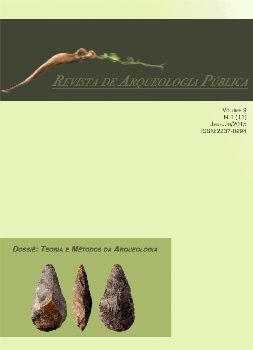Resumo
Tradução da publicação: MERRIMAN, Nick. Introduction – Diversity and dissonance in public archaeology. MERRIMAN, Nick (Ed.). Public Archaeology. London: Routledge. 2004.
Referências
ADORNO, T, e M HORKHEIMER. Dialectic of Elightment. London: New Left Books, 1979(1944).
ASCHERSON, N. Editorial. Public Archaeology, 2000: p.1-4.
BALLANTYNE, R. Interpretin 'Visions'. Adressing Environmental Education Goals Through Interpretation. In: UZZEL D. e BALLANTYNE R. Contemporary Issues in Heritage and Environmental Interpretation. London: Stationary Office, 1998.
COLLEY, S. What happende in WAC-3? Antiquity, 1995: p.15-18.
DOBINSON, C., e S. DENISON. Metal Detecting and Archaeology in England. London: English Heritage/Council for British Archaeology, 1995.
DURANT, J. Editorial. Public Understanding of Science, 1997: p.1-3.
FEDER, K. Ten years after: surveying misconceptions about human past. Cultural Resource Management, 1995: p.10-14.
FFORDE, C, J. HUBERT, e P. (eds). TURNBULL. The Dead and their Possessions: Repatriation in Principle, Policy and Practice. London: Routldge, 2002.
GRAHAM, B., G. J. ASHWORTH, e J. E. TUNBRIDGE. A Geography of Heritage. Power, Culture and Economy. London: Arnold, 2000.
HABERMAS, J. The Structural Transformation of the Public Sphere. Cambridge: Polity Press, 1989(1962).
HEIN, G. Learning in the Museum. London: Routledge, 1998.
HOLTDORF, C. Engaging in multiple pasts. Reply to Francis McManamon. Public Archaeology, p. 214-15.
HOOPER-GREENHILL, E, (ed.). The Educational Role of the Museum. 2nd edition. London: Routledge, 1994.
IRWIN, A., e B. (eds) WYNNE. Misunderstanding Science? The Public Recosntruction of Science and Technology. Cambridge: Cambridge University Press, 1996.
LAYTON, R. (ed.). Conflict in the Archaeology of Living Traditions. London: Unwin Hyman, 1989a.
LAYTON, R. Who needs the past? Indigenous Values and Archaeology. London: Unwin Hyman, 1989b.
LAYTON, R., P. STONE, e J. THOMAS. Destruction and Conservation of Cultural Property. London: Routledge, 2001.
MACDONALD, S. Behind the Scenes at the Science Museum. Oxford: Berg, 2002.
MCGIMSEY, C. R. Public Archaeology. New York: McGraw Hill, 1972.
MCGUIGAN, J. Culture and the Public Sphere. London: Routledge, 1996.
MCMANAMON, F. Archaeological Messages and Messengers. Public Archaeology, 2000: p. 5-20.
MELTON, J. V. H. The Rise of Public in Enlightment Europe. Cambridge: Cambridge University Press, 2001.
MERRIMAN, N. Arhcaeology, heritage and interpretation. In: B. CUNLIFFE, W. DAVIES, C. (eds.) RENFREW. Archaeology. The Widening Debate, Oxford: Oxford University Press/British Academy, 2002.
MERRIMAN, N. Beyond the Glass Case: the Past, the Heritage and the Public in Britain. Leicester: Leicester University Press, 1991.
MORI. Attitudes Towards the Heritage. Research Study Conducted for English Heritage July 2000. 2000.
PICCINI, A. War games and wendy-houses: open-air reconstructions of prehistoric life. In: MERRIMAN, N. Making Early Histories in Museums. Leicester: Leicester University Press, 1999.
POKYTOLO, D; GUPPY, N. Public Opinion and Archaeological Heritage: views from outside the profession. American Antiquity, 1999: p. 400-16.
POKYTOLO, D., MASON, A. Public attitudes towards archaeological resources and their management. In: (eds.) SMITH, G.; EHRENHARD, J. Protecting the Past, por. Baton Rouge, Florida: CRC Press, 1991.
POKYTOLO, D., BRASS, G. Interpreting Cultural Resources: Hatzic Site. In: J. (ed.) JAMESON, Presenting Archaeology to the Public. Digging for Truths, London: AltaMira Press, 1997.
RAMOS, M.; D. DUGANNE. Exploring Public Perceptions and Attitudes about Archaeology. Washington, DC: Society for American Archaeology, 2000.
RORTY, R. Contingency, Irony and Solidarity. Cambridge: Cambridge University Press, 1989.
ROSE, S. Governing the enterprising self. In: P. HEELAS e P. (eds.) MORRIS. The Values of Enterprese Culture. The Moral Debate. London: Routledge, 1992.
ROYAL SOCIETY. The Public Understanding of Science. London: Royal Society, 1985.
SAMUEL, R. Theatres of Memory. London: Verso, 1994.
SCHADLA-HALL, T. Editorial: Public Archaeology. European Journal of Archaeology, 1999: p. 147-158.
SIMPSON, M. Making Representations; Museums in the Post-Colonial Era. London: Routledge, 1996.
SKEATS, R. Debating the Archaeological Heritage. London: Duckworth, 2000.
STONE, P., e R. (eds.) MACKENZIE. The Excluded Past. Archaeology in Education. London: Unwin Hyman, 1990.
TARLOW, S. Decoding Ethics. Public Archaeology, 2001: p. 245-59.
THOMAS, J. Where are we now? Archaeological theory in the 1990s. In: UCKO, P. J. Theory in Archaeology: A World Perspective. London: Routledge, 1995.
TUNBRIDGE, J., e G. J. ASHWORTH. Dissonating Heritage: the Management of the Past as a Resource of Conflict. Chichester: John Wiley, 1995.
WYNNE, B. Public understanding of science research: new horizons or hall of mirrors? Public Understanding of Science, 1992: p. 37-44.
YOFFEE, N., e A. (eds.) SHERRATT. Introduction: the sources of archaeological theory. In: N. YOFFEE e A. (eds.) SHERRATT. Archaoelogical Theory: Why Sets the Agenda?. Cambridge: Cambridge University Press, 1993.
A Revista Arqueologia Pública utiliza a licença do Creative Commons (CC), preservando assim, a integridade dos artigos em ambiente de acesso aberto.

